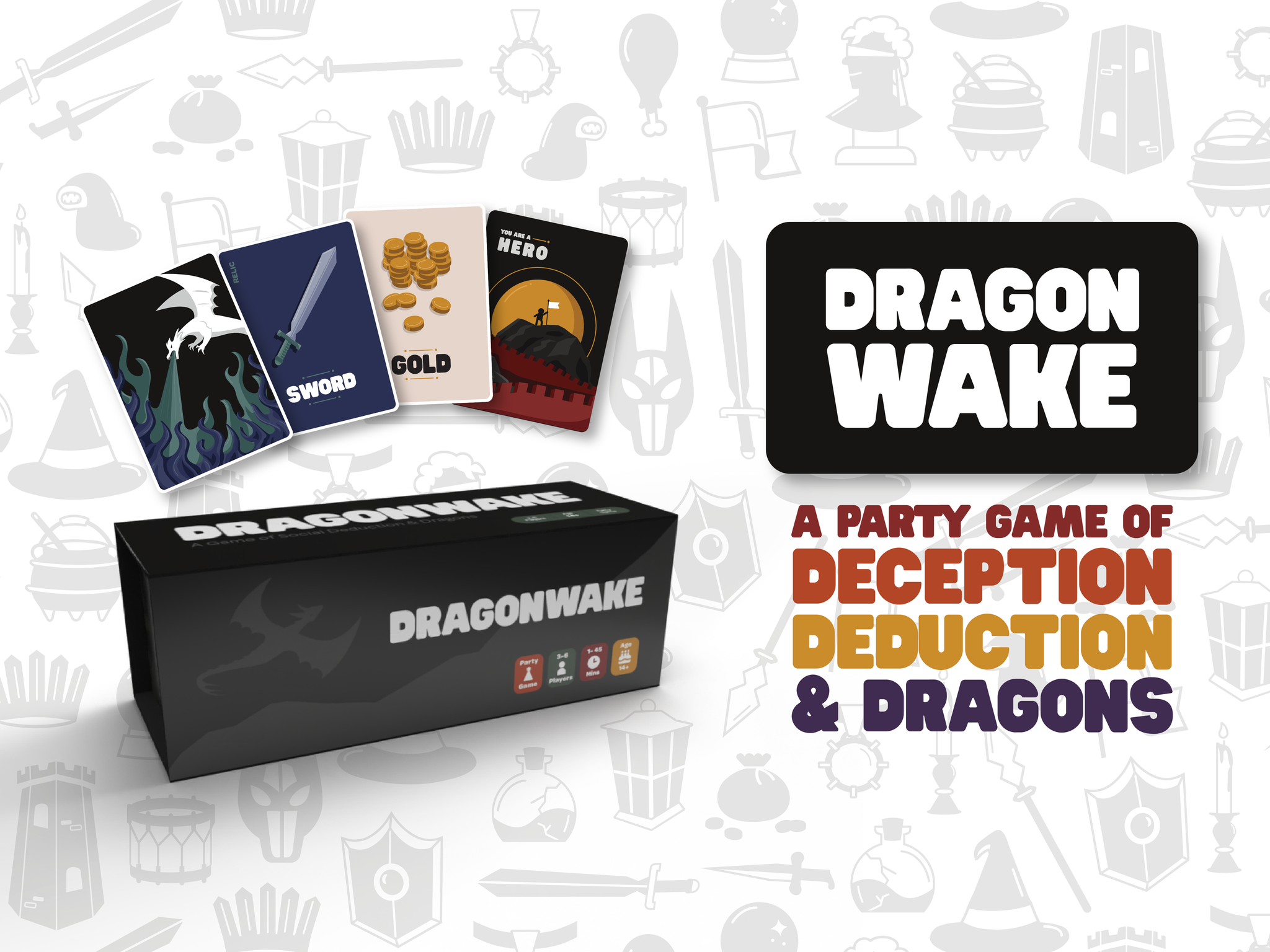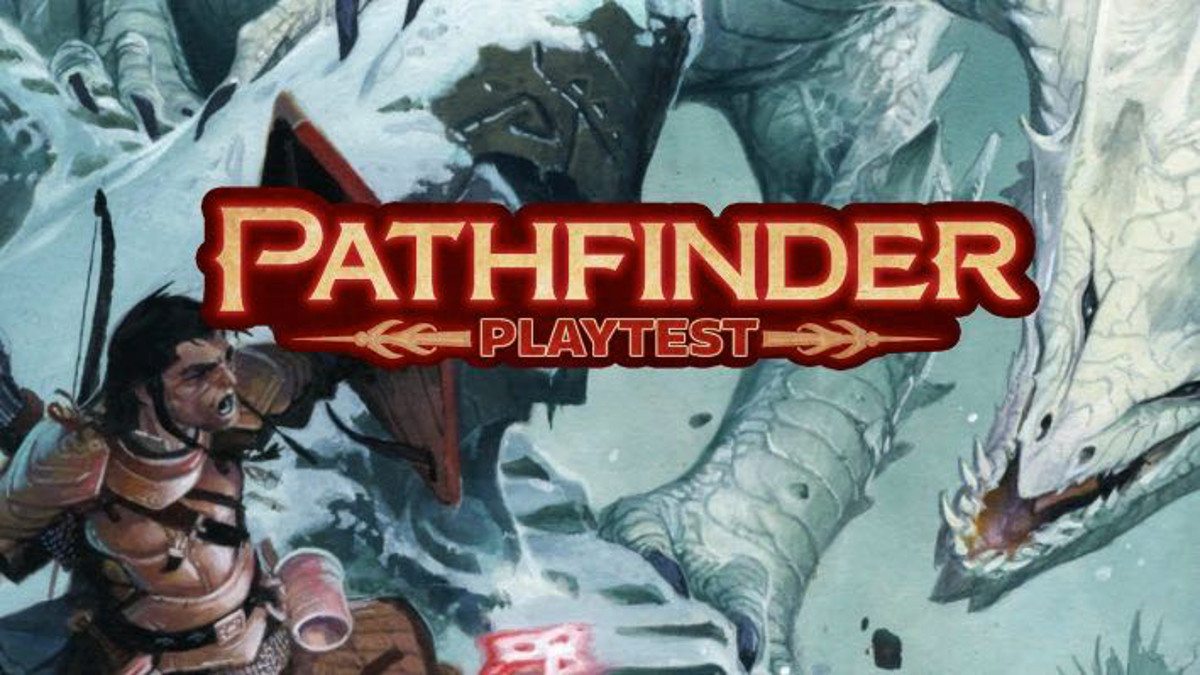You want to kill the dragon and save the world. Your companions do as well. Or do they? Who is a cultist and who is a hero. Find out in Dragonwake!
What Is Dragonwake?
Dragonwake is a game for three to six players, ages 14 and up. The box states that it takes between 1 and 45 minutes to play, and you really will see that wild variation in this game of deception, deduction, and dragons. It is currently seeking funding on Kickstarter, with a pledge level of $25 for a copy of the game. The campaign goes live on May 24, 2022.
Dragonwake is designed, illustrated, and published by OhNo! Games, a trio of three friends who came together and created this game over the past several years. It is always fun to watch new designers, and I can’t wait to see what else they come up with.
New to Kickstarter? Check out our crowdfunding primer.
Dragonwake Components
Note: My review is based on a prototype copy, so it is subject to change and may not reflect the final component quality.
Dragonwake comes in a nice magnetic closure box. The box itself is pretty small, coming in at eight inches by three inches by three inches, making it very easy to take with you to your next gathering. Inside the box, all of the components are nestled in a foam insert to keep them in place. You can tell the design of the box definitely had portability in mind, which is a nice touch.
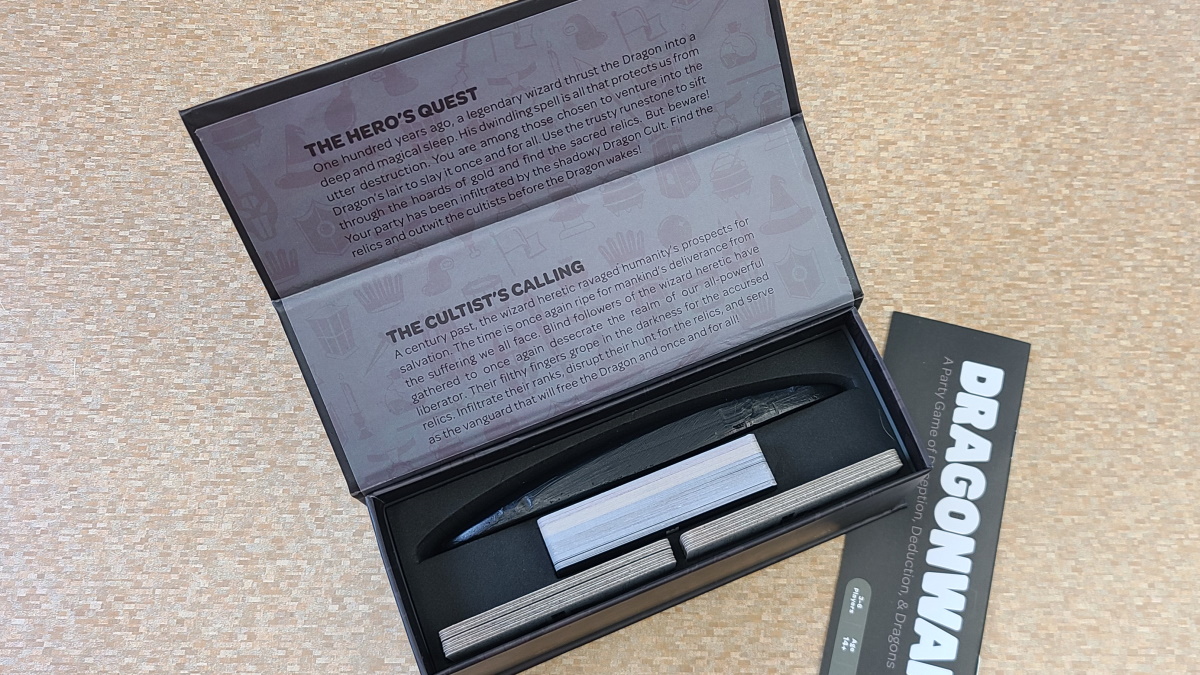
Inside the box you will find:
- 9 role cards
- 41 search cards
- 14 power cards
- 8 event cards
- Runestone
- Instruction manual
The role cards are made from thick cardboard, making them very sturdy and easy to differentiate from the other cards in the game. There are two types of role cards—heroes and cultists. Each player is randomly dealt a role card to give them their role in the game and their win conditions. The life of a hero is tough, and appropriately it is much harder to win Dragonwake as a hero, while the cultists get off easy and really just need to make sure the heroes don’t win!
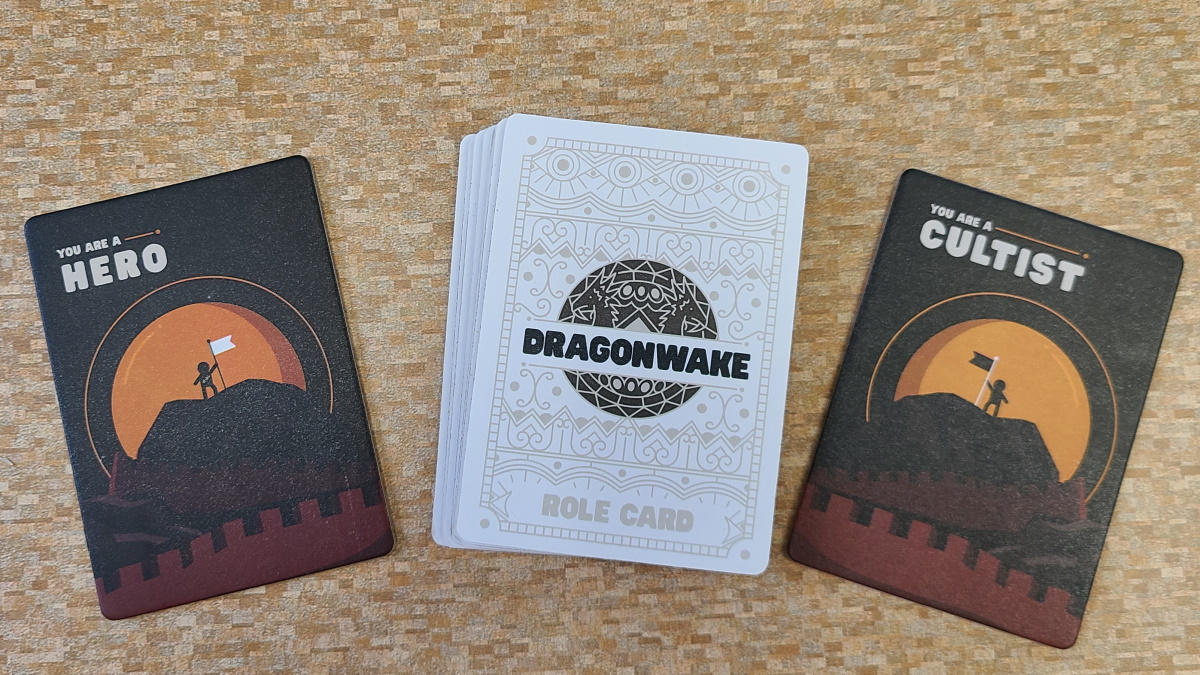
There are several different kinds of cards that are called search cards. These are the cards you are turning over as you are searching for the dragon or the relics to kill the dragon. These cards are nicely manufactured with an embossed finish that makes them easy to work with and not too slippery. Dragonwake offers a few ways to increase or decrease the complexity of the game, and at the least complex, you have three different kinds of search cards.
The first, and most common, is gold. Unfortunately in Dragonwake, gold has no value and just gets in the way of your search for your true goal. The second kind of search card is a relic card. There are six different relic cards in the game, all of which you would expect a hero would need to slay a dragon. There is a helmet, gauntlets, armor, shield, sword, and daggers. Finally, you have the dragon card itself (two are provided with different color schemes).
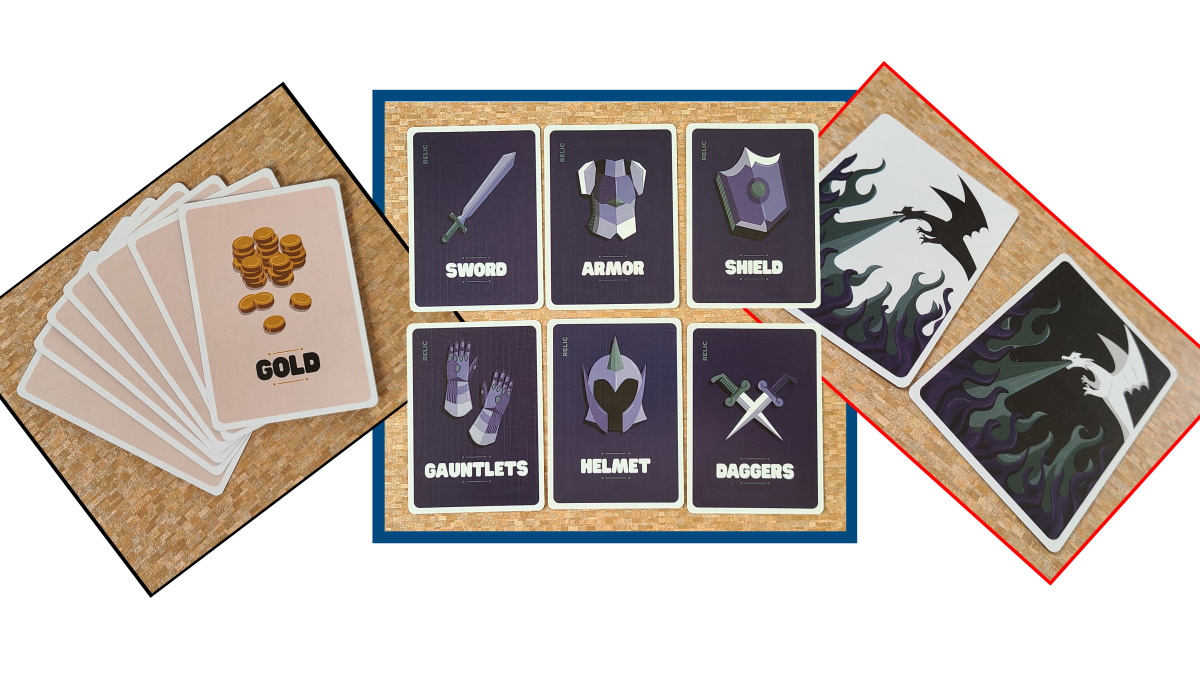
The runestone is a fun component in Dragonwake that might seem gimmicky at first, but after a few plays, you will find yourself using it to keep track of cards, players, and perhaps even whose turn it is to get the drink refills. At a basic level, the runestone is a black shard object with engraved runes on it. In terms of the game, you spin it to tell you the first player, and you use it to point to the card you want to be revealed on your turn. This player, the one holding the runestone, is called the runebearer. But there is more to it than meets the eye! When I was unboxing the game, we spun the runestone in both directions. It worked great going clockwise, but counter-clockwise, it would start to vibrate and shake and get generally unstable. Then it would slowly turn the other way. When I reported this strange issue to the designers, they laughed and told me the runestone is a rattleback, which is a semi-ellipsoidal top that is designed to spin in a preferred direction. So go ahead and go down the rabbit hole researching rattlebacks and watching videos about them. I know I did!
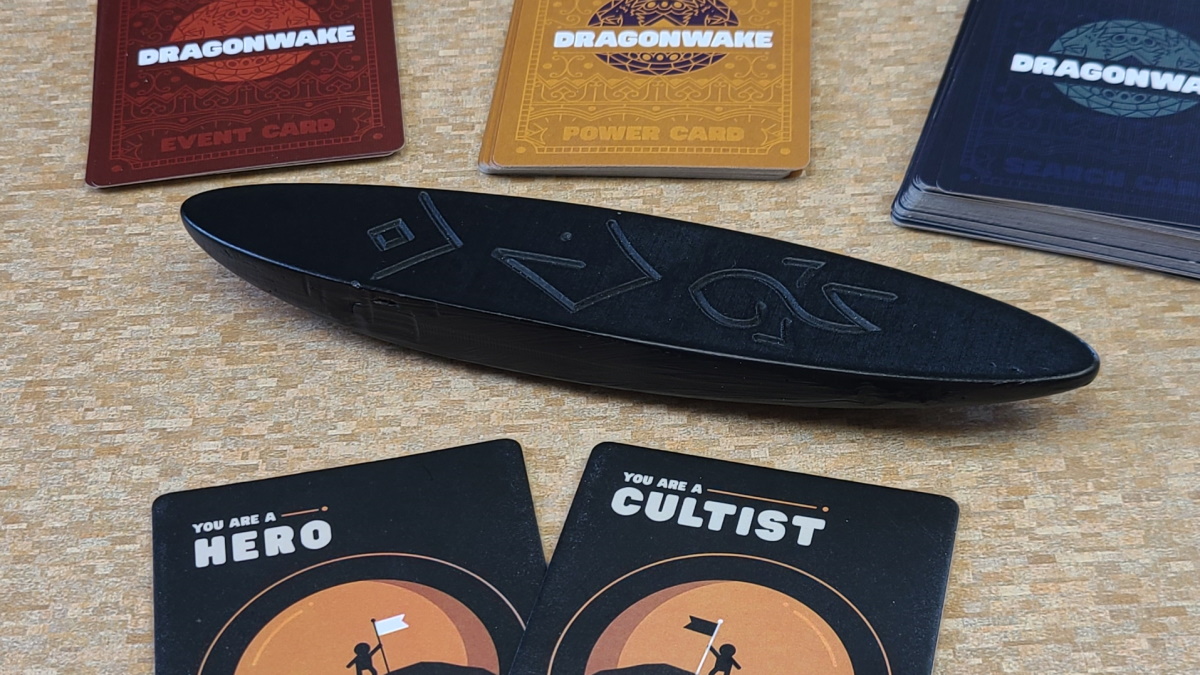
Finally, there are some optional cards included in the game to change certain features and add different elements to your turns. The power cards, if you want to use them, can be dealt to each player. It is up to you how many you give each player, but the instructions suggest one or two. The power cards give each player a unique ability that can be activated during the game to help you or hinder others. The players will keep the power cards concealed until they are ready to use them, and each power card tells you when it can be used. Once a power card is used, it’s turned face up to show that it has already been used. Personally, when we used power cards in my gaming group, I enjoyed playing with a single card per player.
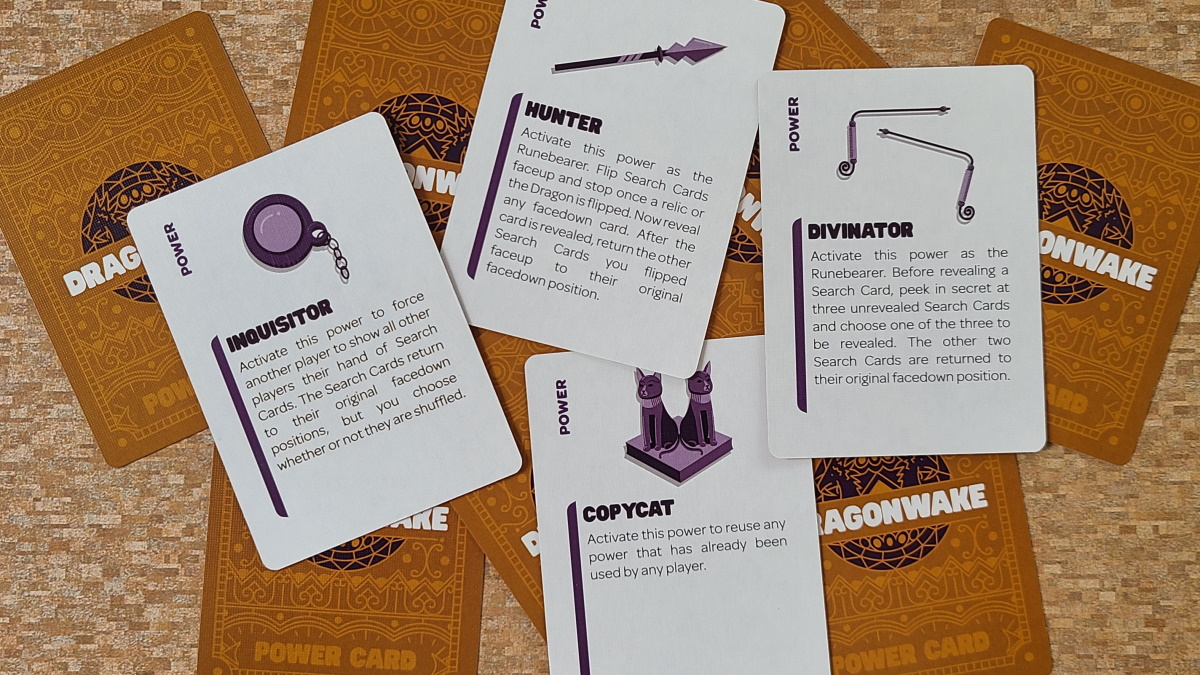
The event cards, like the power cards, are designed to introduce different effects each turn that affect all players. If you use the event cards, you reveal a new one on each turn before the search cards are dealt, and read the text on the card so all players are aware of it. The events add some fun twists to the game, and if you play a few rounds without the event cards, you can really appreciate the changes they incorporate. We did make the mistake of revealing the event card after the players had their search cards and quickly realized our error when the Eclipse event card came up that made us play without knowledge of our search cards. This is why you make sure you reveal the event cards first.

The artifact cards replace gold in the search deck. At the beginning of the game, you create the search deck with a certain number of cards based on the number of players. If you choose to use artifacts, you will pull out a number of gold cards and replace them with the same number of artifact cards. The number of artifacts you use is up to you. When an artifact card is revealed during play, you read the text on the card, and the runebearer that revealed the artifact follows those instructions.
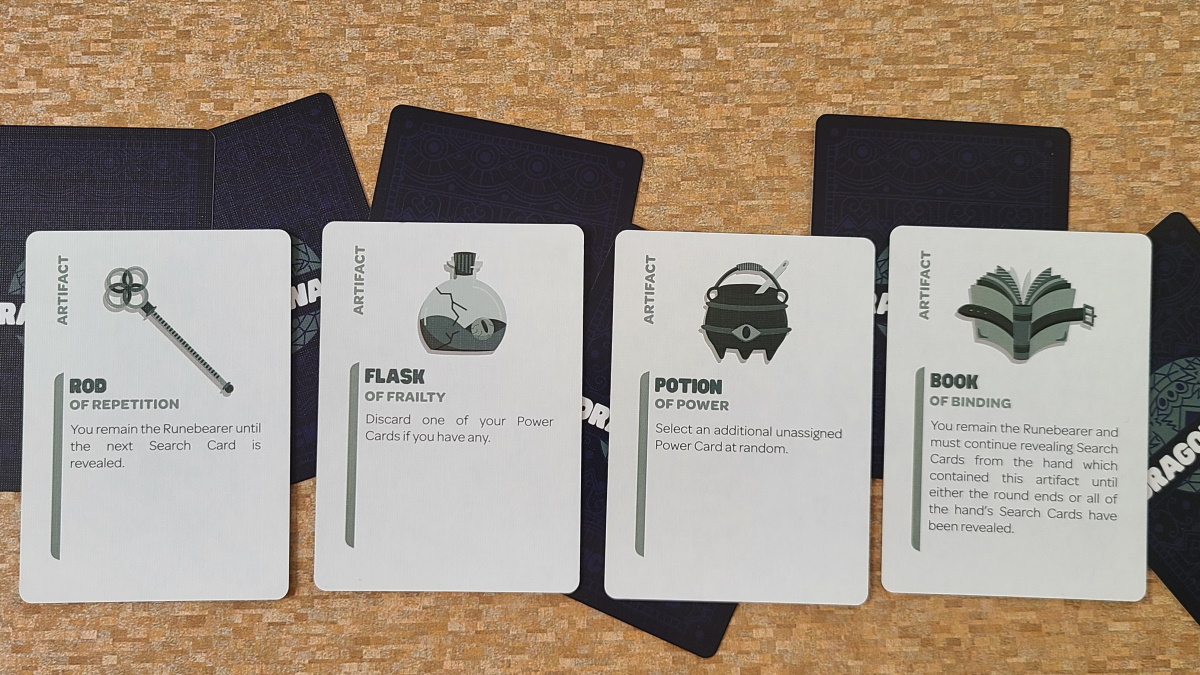
One thing I really do like about these additional cards is that you can play with as many of them as you want. If you find one that you feel is too powerful, you can simply set it aside and not use it. This is actually stated in the official rules and brought up again in the online FAQ for the game. Do you only want three artifacts in your search deck? Great! Wait, you only want three gold and the rest artifacts? Okay, go for it! This flexibility at the core of the game helps add to the replay value and laughs as you encounter new cards you never played with before.
How to Play Dragonwake
If you are interested in reading the instructions on how to play, you can find them online at the OhNo! Games website. Better yet, OhNo! Games has produced a very witty video you can watch to learn how to play as well.
What Am I Trying to Do
The first question is, are you a hero or are you a cultist? If you are a hero, you have one win condition…slay the dragon! The dragon is slain if all the relic cards are revealed before the dragon card is revealed or before four rounds are played. If you are a cultist, your win condition is either someone revealing, and therefore waking, the dragon card before the heroes find all the relics and slay the dragon. Or simply hold out four rounds without the heroes finding what they need and you will win by default as the dragon wakes up on its own.
Setting up the Game
Preparing to play Dragonwake is probably the most fiddly part of the entire game and takes referring to some setup charts the first few times you play. Following the charts, you will create one deck containing the hero and cultist role cards, and one deck containing the search cards consisting of gold, relic cards, and the dragon. Once you realize that the search deck always contains cards totaling five times the number of players and that there is one relic put in the deck per player, you can easily set it up without referring to the chart. For instance, with four players, your search deck will have 20 cards (five times four players is twenty cards). Of those 20 cards, four will be relics, because there are four players, one will be the dragon, and the remaining 15 will be gold.

If you are playing with artifacts, this is the time you would pull out a number of gold cards and replace them with artifact cards. In your four-player game, perhaps you pull out five gold cards and replace them with five artifact cards. Also, go ahead and shuffle up your event cards and power cards if you are using them.
Have each player choose one role card from the deck you created. They will look at the card but keep it hidden from all other players. If you are using power cards, this is the time to distribute those to the players so they can look at and understand them. Now spin the runestone, and whomever it points at when it stops is the lucky runebearer and the first player.
Playing Dragonwake
Now that you are ready to play, if you are using event cards, go ahead and reveal one. Read the card out loud so all the players know what event is in effect this round. For example, there is an event card named Chaos that makes the runebearer swap role cards with the owner of any gold card the runebearer reveals on their turn. As you can imagine, this introduces some interesting knowledge into this hidden knowledge game and makes the bluffing even more fun.
The search deck is then dealt out to all players, so all players end up with five cards. Each player goes ahead and looks at those cards in secret (unless an event tells you not to) and does their best to remember what cards they have in their hand. They then mix them up and deal them face down in front of themselves. Now comes the fun part as each player, starting with the first player, declares what is in their hand. This is your opportunity to try to draw people in to picking your relics or scaring them away from the dragon in your hand. You can say pretty much anything about the search cards in your hand. You can state that you have three relics, or all gold, or even that you have the dragon. What you declare will be based on your goals from the role you are playing and the current state of the game, so have fun with it!
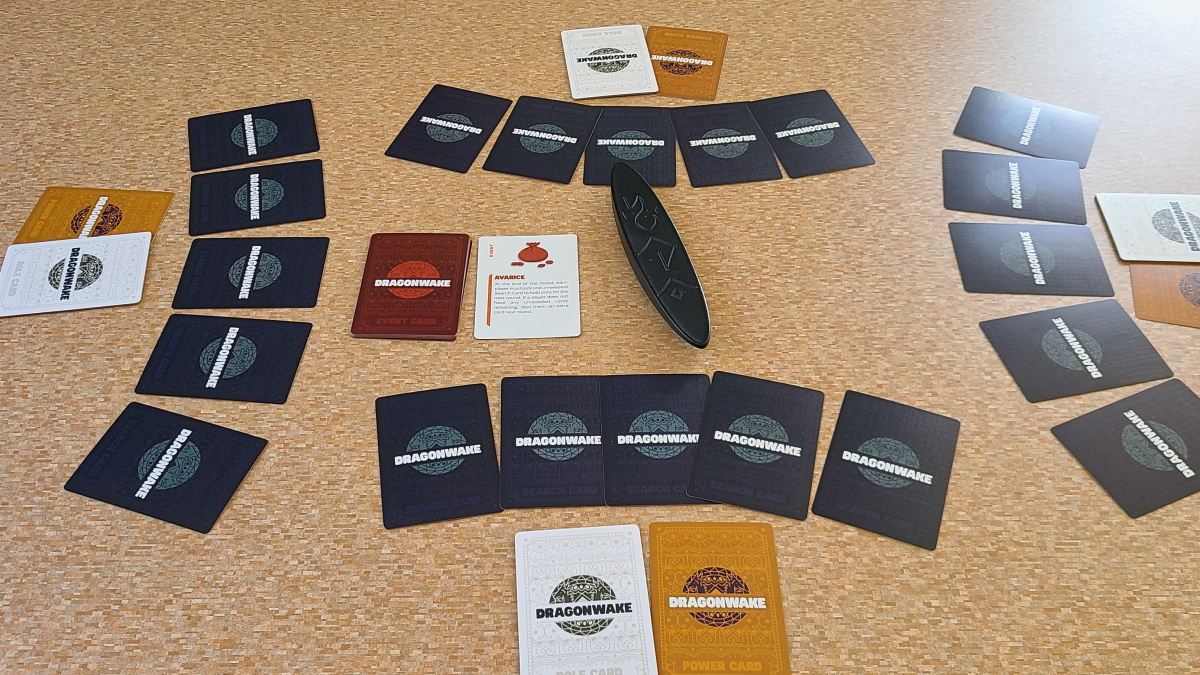
The runebearer takes the runestone and uses it to point to a card they want to be revealed. The player that owns the card turns it over, revealing what it is. If it is gold, everyone groans, and play moves on. Of course, if a relic was revealed, the heroes celebrate, and perhaps the cultists celebrate too in order to throw the heroes off their trail. If you are playing with and reveal an artifact, then the runebearer takes whatever action the card dictates. If you revealed the dragon, the cultists throw off their disguises and celebrate, because the dragon takes over the world and they instantly win!
Now comes what Dragonwake calls the cleanup phase. Assuming the dragon was not revealed, the player who had to reveal their card becomes the new runebearer, taking the runestone, and choosing another player’s card to reveal. This continues until you have revealed as many cards as there are players, so in a five-player game, reveal five cards, then the round is over. At the end of the round, any relics are left face-up in the center of the play area, and gold and artifacts are discarded. All of the remaining face-down cards are gathered up, shuffled, and dealt out again, with each player getting one less card than the last round. Again, take a look at your cards, mix them up, place them face down in front of you and prepare to make your declaration about your current hand of cards.
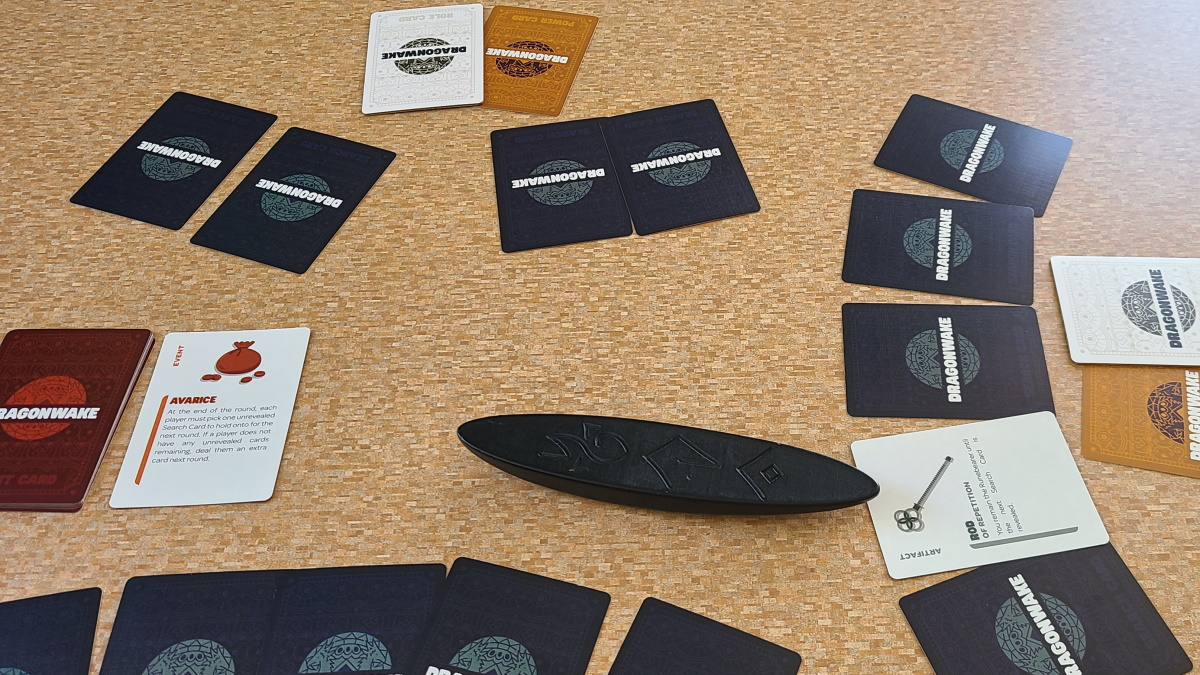
The End of the World (And the Game)
Rinse, repeat, and that’s the game! Just remember the win conditions, which trigger immediately based on what is revealed. The only way for the heroes to win is to reveal all relic cards, and there is one for each player. So as soon as that fifth relic is turned up in a five-player game, the heroes win. If the dragon is turned up, the cultists immediately win, and at the end of the fourth round, if neither heroes nor cultists have won, the dragon wakes up, and yes, the cultists win.
You are probably noticing that it is much easier for the cultists to win than the heroes. While that is true, my game group did not feel that detracted in any way from the game itself. In fact, during our gameplay, the heroes never won, but we all still had a good time!
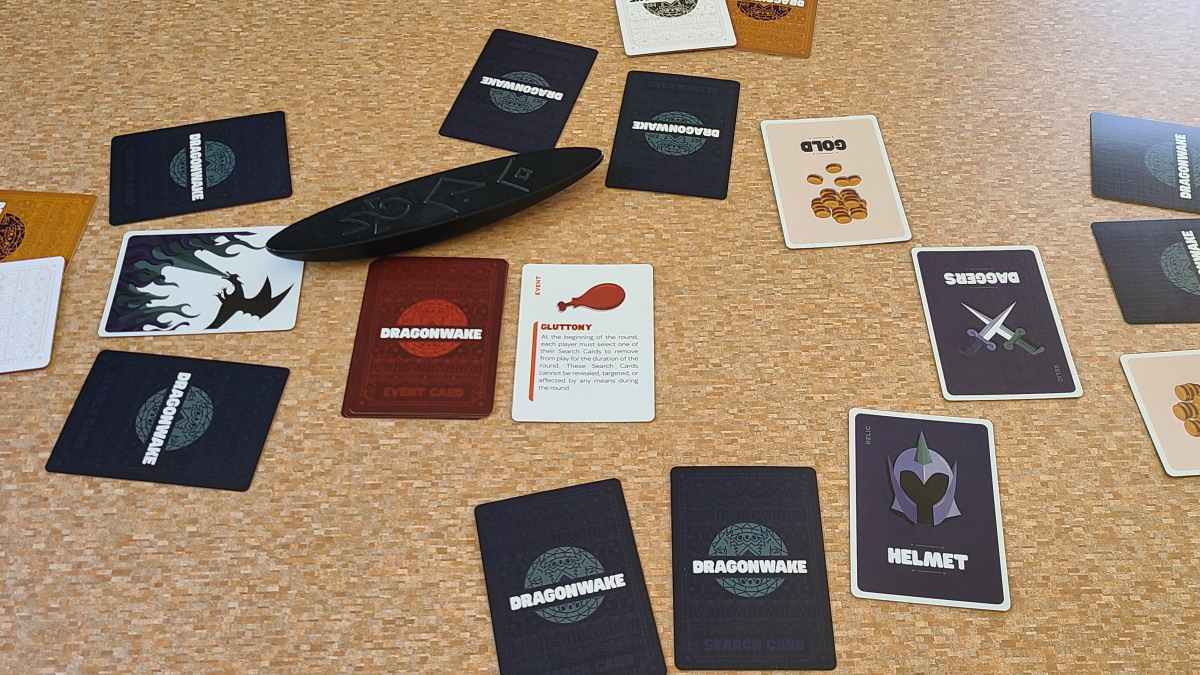
Why You Should Play Dragonwake
During my first few plays of Dragonwake, when I was running through it alone, it didn’t seem very dynamic. Then my girlfriend played it with me to test it out, and since you need three players, we each played two hands. It was better, but again, it seemed to be lacking something. When we got our game group together and played it, I found out what had been lacking. Other people!
The deception aspect of the game really works for Dragonwake and really works better as you get into higher player counts. I have played it with three, four, and five players, and everyone really enjoyed the game, but it felt more fun as the player count increased. We played several hands, starting without any extra cards, then adding artifacts, events, and power cards as we played subsequent games. Again, I had been feeling that the extra cards didn’t add enough, but when the game was played as it was intended, those cards became much more fun, providing several “wow” and “oh no” moments. Perhaps that is why the designers chose OhNo! Games as the name for their company?
One thing I’m still not 100% sold on is the runestone itself. Do you really need to use the runestone? On a large table, it was difficult to use it to point to a card and hard to pass it back and forth easily without having it handed from player to player. Dragonwake is also a game that is casual enough that a lot of conversation and talking happens during the game, and that adds a lot to the charm of the game but revealed that our memories were somewhat faulty. We found that we tended to forget who was to go first from round to round, and we discovered that the runestone is truly useful in keeping track of whose turn it is. Otherwise, it is a really cool component, and the deep dive you do to learn about rattlebacks is totally worth it, but we found it easier to just point to a card without it.
A few in our gaming group pointed out that some of the wording can be a bit vague, which isn’t a huge surprise for the first outing of new game designers. To OhNo! Games’ credit, they have published a very useful FAQ on the Dragonwake website that I would recommend everyone read if you are planning to pick up and play the game. It has some great clarifications on how some of the cards interact. I’ve also pointed out that I like the flexibility of adding and removing cards to make the game what you want it to be, but one person felt this added to the feeling of vagueness about the game. For me, it wasn’t an issue, and remember, you are more than welcome to play the game as presented in the instructions without modifications.
Overall I’m glad Dragonwake is in my library. It is a fun game with a larger group, and it serves well as a quick game to get everyone ready to play other games or as a lighter break during a gaming session. The playtime can range from ending on the first card revealed (yes, that happened to us) to going on for 30 or more minutes if you have six players and no one is doing their jobs and finding the right cards! Do yourself a favor and check out this Kickstarter and see if Dragonwake is a good fit for you!
For more information or to make a pledge, visit the Dragonwake Kickstarter page!
Click here to see all our tabletop game reviews.
![]() To subscribe to GeekDad’s tabletop gaming coverage, please copy this link and add it to your RSS reader.
To subscribe to GeekDad’s tabletop gaming coverage, please copy this link and add it to your RSS reader.
Disclosure: GeekDad received a copy of this game for review purposes.
